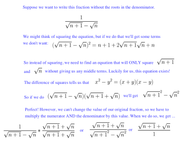
Let n = 2.
Then:
1/(√n+1 - √n) = 1/(√3-√2) ≈ 1/(1.7 - 1.4) = 1/.3 = 10/3. This is our target.
Now plug n=2 into the answers to see which comes closest to our target of 10/3.
Only
E works:
√(n+1) + √n = √3+√2 ≈ 1.7 + 1.4 = 3.1.
The correct answer is
E.
Private tutor exclusively for the GMAT and GRE, with over 20 years of experience.
Followed here and elsewhere by over 1900 test-takers.
I have worked with students based in the US, Australia, Taiwan, China, Tajikistan, Kuwait, Saudi Arabia -- a long list of countries.
My students have been admitted to HBS, CBS, Tuck, Yale, Stern, Fuqua -- a long list of top programs.
As a tutor, I don't simply teach you how I would approach problems.
I unlock the best way for YOU to solve problems.
For more information, please email me (Mitch Hunt) at
[email protected].
Student Review #1
Student Review #2
Student Review #3























